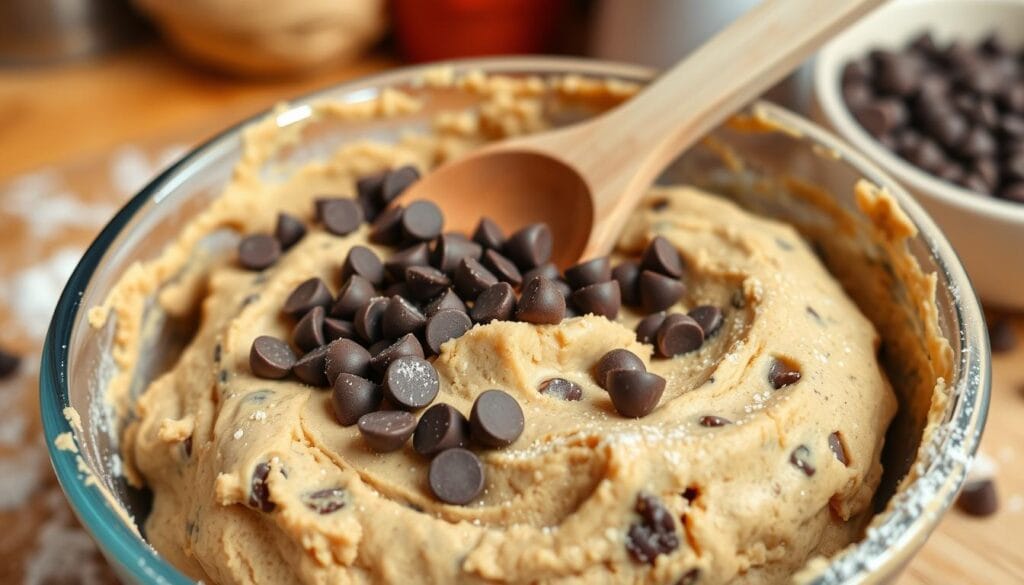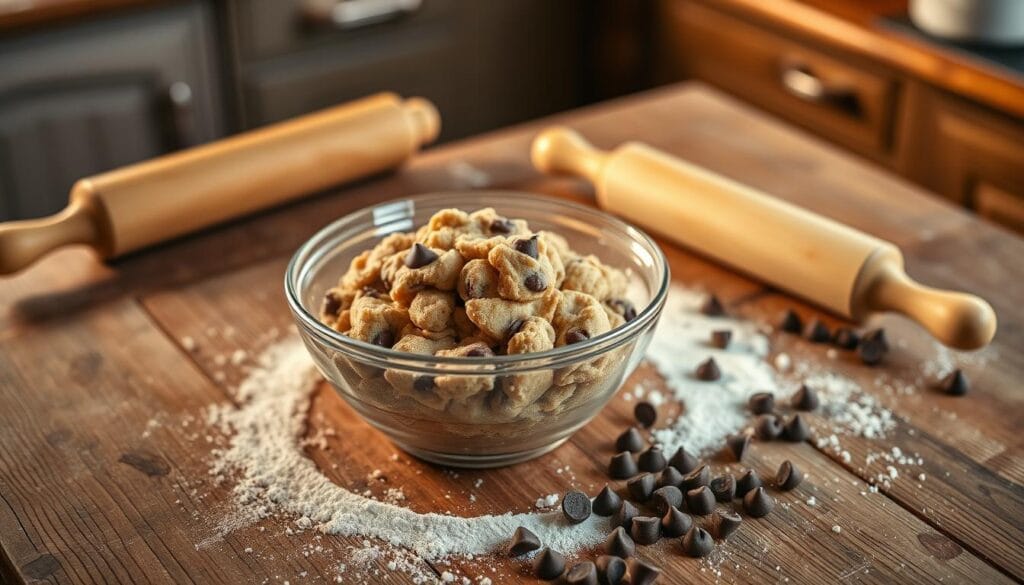Growing up, my grandmother’s homemade Toll House cookies were a family tradition. The warm, gooey dough and melty chocolate chips were always the highlight, even before the cookies were baked. But as a child, I was often scolded for sneaking tastes of the raw batter, as we were warned about the potential dangers of consuming uncooked dough. Now, as an adult, I’m thrilled to learn that Nestle has found a way to make their iconic Toll House cookie dough safe to eat raw.
The introduction of Nestle’s edible cookie dough has changed how we enjoy this beloved treat. No longer do we have to resist the temptation of the unbaked batter. Nestle has addressed the primary food safety concerns through advancements in their manufacturing process. With the removal of raw eggs and using heat-treated flour, the risk of salmonella and E. coli has been significantly reduced. This allows us to indulge in the delightful experience of eating Toll House cookie dough straight from the tub.
Main Highlights
- Nestle Toll House has introduced edible cookie dough that is safe to consume raw.
- Advances in the manufacturing process have addressed traditional food safety concerns, such as salmonella from raw eggs and E. coli from uncooked flour.
- The removal of raw eggs and heat treatment of the flour have made Toll House cookie dough a safe and enjoyable treat to eat straight from the tub.
- Nestle’s edible cookie dough allows us to indulge in the delicious experience of the raw batter without the guilt or health risks associated with traditional raw dough.
- Consumers can now savor the classic Toll House flavor in a safe and convenient way, satisfying their cravings for the beloved cookie dough.
Understanding Raw Cookie Dough Safety
It’s tempting to eat raw cookie dough, but it’s not safe. Raw cookie dough can have Salmonella from eggs and E. coli from flour. These can make you very sick, with symptoms like fever and stomach pain.
But, there’s good news. Today, cookie dough is safer to eat. Brands like Nestle Toll House use special flour and eggs that are safe. The FDA also says it’s okay to eat cookie dough made with these safe ingredients.
Food Safety Guidelines
- Avoid eating raw cookie dough or uncooked batter, as they may contain dangerous pathogens.
- Look for cookie dough products that are specifically labeled as “safe to eat raw” or “edible cookie dough,” as these have been specially formulated for safe consumption.
- When handling raw cookie dough, be sure to follow proper food safety guidelines, such as washing your hands, avoiding cross-contamination, and properly storing the dough.
Knowing the risks and the safety steps can let you enjoy raw cookie dough safely. It’s a tasty treat that won’t harm you.

The Evolution of Nestle Toll House Cookie Dough
Nestlé Toll House is known for its classic chocolate chip cookies. It has changed to meet today’s need for safe-to-eat raw products. Its cookie dough is a favorite in American baking.
Nestlé has seen more people want edible cookie dough. So, they made new recipes that are safe to eat right from the package. This makes it safe to enjoy without worrying about getting sick.
The company listens to what people want. This helps Nestlé Toll House stay popular in the nestle toll house cookie dough, edible cookie dough, and cookie dough ingredients world.

Nestlé Toll House keeps improving. It stays true to its quality and safety. This makes it a favorite in many kitchens. Nestlé Toll House is set to be loved for years to come.
Can You Eat Nestle Chocolate Chip Cookie Dough?
Yes, you can now enjoy Nestle Toll House chocolate chip cookie dough safely. The company has changed its recipe. Now, it’s safe to eat without worry.
Safe Consumption Guidelines
Nestle Toll House uses pasteurized eggs and heat-treated flour. This makes the dough safe from salmonella and E. coli. You can eat it raw, bake it, or use it on ice cream.
Product Labeling Information
Look for the “Edible Cookie Dough” label on Nestle Toll House cookie dough. It shows the dough is safe to eat raw. The packaging also has storage and handling tips for safety.
Storage Requirements
- Refrigerate cookie dough at 40°F (4°C) or below and consume within 1 week.
- Freeze cookie dough at 0°F (-18°C) or below for up to 3 months.
- Always follow the manufacturer’s storage and handling instructions for best quality and safety.
Follow these guidelines to enjoy Nestle Toll House chocolate chip cookie dough safely. It’s a classic treat now safe to eat raw.

Raw Ingredients and Their Safety Concerns
Cookie dough can be risky if it’s not cooked right. Raw eggs and flour can have Salmonella and E. coli. Eating raw cookie dough or uncooked batter can make you very sick. You might get a fever, vomit, or even worse.
Eggs and flour in cookie dough can make you sick. The Centers for Disease Control and Prevention (CDC) warns about eating raw cookie dough. But, now we have edible cookie dough that’s safe.
- Nestlé Toll House made their cookie dough safe by removing raw eggs and using special flour.
- The CDC found E. coli in raw flour, showing why safe cookie dough is important.
- Brands like Nestlé Toll House and Pillsbury use safe eggs and flour in their edible cookie dough.
Knowing the risks of raw cookie dough helps us stay safe. Now, we can enjoy cookie dough without worrying. Thanks to edible cookie dough, we can have fun and stay healthy.
How Nestle Makes Cookie Dough Safe to Eat
Nestlé has found a way to make cookie dough safe to eat. They use a special method to make their Toll House cookie dough safe. This way, they keep the dough’s taste and texture the same.
Heat Treatment Process
Nestlé’s secret is its heat treatment process. They heat the flour to reduce harmful bacteria like E. coli. This step is key to making the dough safe to eat.
Ingredient Modifications
Nestlé also changes the ingredients in their dough. They use pasteurized eggs or egg substitutes to avoid Salmonella. They also check the safety of all their ingredients very carefully.
Quality Control Measures
Nestlé is very careful about making their dough safe. They test and inspect their safe cookie dough often. This means you can enjoy Nestlé Toll House cookie dough without worrying about getting sick.
Nestlé’s safety steps let people enjoy cookie dough without fear. Their focus on safe cookie dough has changed how we can enjoy Toll House treats.
Different Types of Edible Nestle Cookie Dough Products
The Nestle brand is known for tasty and safe-to-eat cookie dough. They offer more than just the classic Nestle Toll House Chocolate Chip Cookie Dough. They have many other kinds to meet different tastes and needs.
For fans of the classic Toll House flavor, Nestle has Nestle Toll House Chocolate Chip Edible Cookie Dough and Nestle Toll House M&M’s Minis Chocolate Chip Cookie Dough. These doughs are safe to eat straight from the fridge. They let you enjoy the taste of Toll House cookies without baking.
Nestle also has Nestle Toll House Mini Chocolate Chip Cookie Dough and Nestle Toll House Ultimates Chocolate Chip Lovers Cookie Dough. These offer different textures and tastes. They’re perfect for those who like something new.
| Product | Description | Price |
|---|---|---|
| Nestle Toll House Chocolate Chip Cookie Dough | The classic Toll House chocolate chip cookie dough, is designed for safe raw consumption. | $5.99 |
| Nestle Toll House Chocolate Chip Edible Cookie Dough | A version of the classic Toll House chocolate chip flavor, specifically formulated for edible raw enjoyment. | $6.99 |
| Nestle Toll House M&M’s Minis Chocolate Chip Cookie Dough | A fun twist on the classic, featuring mini M&M’s chocolate candies throughout the dough. | $7.99 |
| Nestle Toll House Mini Chocolate Chip Cookie Dough | Bite-sized pieces of chocolate chip cookie dough for a delightful snacking experience. | $5.99 |
| Nestle Toll House Ultimates Chocolate Chip Lovers Cookie Dough | A decadent, extra chocolatey version of the Toll House classic, perfect for true chocolate enthusiasts. | $8.99 |
Nestle keeps making new edible cookie dough options. They want to make sure everyone can enjoy the Toll House taste in many ways. Whether you like the classic, M&M’s, or extra chocolate, Nestle has it.
The History of Toll House Cookies
The Toll House chocolate chip cookie has a long history, starting in the 1930s. It was created by Ruth Wakefield, the owner of the Toll House Inn in Massachusetts. She accidentally made the famous chocolate chip cookie.
Ruth Wakefield’s Innovation
In 1938, Ruth Wakefield was making chocolate cookies. She chopped up a Nestlé semi-sweet chocolate bar and added it to the dough. She thought it would melt and mix with the dough.
To her surprise, the chocolate chunks stayed whole. This created a new cookie with chocolate chips in it.
Partnership with Nestlé
Ruth Wakefield teamed up with Nestlé after her creation. They used her recipe to promote Nestlé’s chocolate bars. This partnership was a big success for both sides.
The Toll House cookie became very popular. It also helped Nestlé’s chocolate products sell more.
Evolution to Modern Products
Nestlé later made chocolate chips just for baking. This made it easier for people to make the Toll House cookie at home. As time went on, Nestlé also made ready-to-bake and edible cookie dough.
Today, the Toll House chocolate chip cookie is a favorite in America. Its story shows how innovation and classic foods can last forever.
Proper Storage and Handling Tips
Keeping your Nestle cookie dough safe and fresh is key. Follow these tips to keep your dough in top shape:
- Refrigerate the cookie dough: Always store your Nestle refrigerated cookie dough in the refrigerator as indicated on the packaging. Keeping the dough at the appropriate temperature is key to preserving its safety and quality.
- Follow storage duration guidelines: Check the expiration date on the package and adhere to the recommended storage duration. Refrigerated cookie dough typically lasts 2-4 days in the fridge, while frozen dough can be stored for up to 2 months.
- Handle with clean utensils: Use clean hands and utensils when scooping or handling the refrigerated cookie dough to prevent cross-contamination and maintain food safety.
- Avoid temperature fluctuations: Minimize the number of times you take the cookie dough in and out of the refrigerator to prevent temperature fluctuations, which can impact the dough’s safety and quality.
- Discard expired dough: If the refrigerated cookie dough has passed its expiration date or shows signs of spoilage, it’s best to discard it to avoid potential foodborne illnesses.
By following these simple tips, you can enjoy your Nestle cookie dough safely. This ensures a delicious and worry-free baking experience.
| Storage Condition | Shelf Life |
|---|---|
| Refrigerated | 2-4 days |
| Frozen | Up to 2 months |
Always follow the manufacturer’s guidelines for safe handling and storage. This way, you can enjoy the delicious taste while keeping food safety in mind.
Nutritional Information and Ingredients
Nestlé Toll House cookie dough is made with quality ingredients. They’ve added 10% more chocolate chips for a chewier texture. You can find detailed nutrition and ingredient lists on the packaging.
Nestlé cares about responsible sourcing, especially for cocoa. Their Nestlé Cocoa Plan promotes ethical and sustainable practices. This helps cocoa farmers and their communities.
| Nutrient | Amount per Serving |
|---|---|
| Calories | 170 |
| Total Fat | 9g |
| Saturated Fat | 5g |
| Cholesterol | 20mg |
| Sodium | 170mg |
| Total Carbohydrates | 21g |
| Dietary Fiber | 1g |
| Sugars | 13g |
| Protein | 2g |
The main cookie dough ingredients are enriched flour, sugar, nestle toll house chocolate morsels, butter, eggs, and vanilla extract. Nestle has crafted these edible cookie dough recipes for a safe and tasty experience.
Health Considerations When Consuming Raw Dough
Nestle’s chocolate chip cookie dough is safe to eat raw. But, it’s important to think about your health when eating these treats. Raw dough can have harmful bacteria like Salmonella and E. coli.
Salmonella comes from animal waste and can be in raw eggs. Raw flour, used in cookie dough, can also have Salmonella and E. coli. The CDC says eating raw flour can cause illness, as seen in 2023.
Eating contaminated food can make you sick. You might get fever, diarrhea, stomach pain, and headaches. Nestle’s dough is safe, but it’s still important to watch your health.
- Raw flour, found in baking mixes and store-bought cookie dough, can harbor harmful bacteria like Salmonella and E. coli.
- Foodborne illnesses from raw flour or eggs can cause symptoms like fever, diarrhea, and abdominal cramps.
- Pasteurized-in-the-shell eggs and heat-treated flour are recommended to reduce the risk of bacterial contamination.
- Moderation is key, even with safe-to-eat raw cookie dough products, as they may be high in sugar and calories.
- Individuals with specific dietary restrictions or health concerns should consult the nutritional information and ingredients before consuming raw cookie dough.
Knowing the health risks and being careful can help you enjoy raw cookie dough safely. This way, you can have fun while keeping your health in mind.
Conclusion
The Nestlé Toll House brand has made it safe to eat raw cookie dough. They’ve found new ways to make their edible cookie dough safe. This means you can enjoy the taste without worrying about getting sick.
It’s great that you can now enjoy the taste of raw Toll House cookie dough safely. But, remember to eat it in moderation. Always keep it in the fridge or freezer and check the expiration date. Baking it at the right temperature is also key to a safe and tasty treat.
Thanks to Nestlé’s safety steps, you can enjoy the classic Toll House flavor without fear. Whether you want to bake cookies or just enjoy the dough, Nestlé’s focus on safety lets you do it with confidence.
FAQ
Can you eat Nestle chocolate chip cookie dough?
Yes, Nestle now has edible cookie dough that’s safe to eat raw. It uses pasteurized eggs and heat-treated flour. This makes it safe from foodborne illness.
What are the traditional risks of consuming raw cookie dough?
Eating raw cookie dough used to be risky. Raw eggs could have Salmonella, and uncooked flour could have E. coli. These can make you sick if you eat the dough raw.
How have modern safety improvements addressed the risks of raw cookie dough?
Now, flour is heat-treated and eggs are pasteurized. This reduces harmful bacteria. So, the dough is safe to eat without cooking.
What are the key steps Nestle takes to ensure the safety of their edible cookie dough?
Nestle makes their cookie dough safe by heat-treating flour and using pasteurized eggs. They also check their products for quality and safety.
What types of edible cookie dough products does Nestle offer?
Nestle has many edible cookie dough flavors, like chocolate chip. You can find them in the fridge at grocery stores. They’re made for eating raw.
How should Nestle cookie dough products be stored and handled?
Keep Nestle cookie dough in the fridge at the right temperature. Follow the package’s storage and handling tips to keep it safe and fresh.
What health considerations should be taken when consuming raw cookie dough?
Nestle’s raw cookie dough is safe to eat, but it’s still high in sugar and calories. Eat it in moderation. People with dietary restrictions should check the ingredients first.

